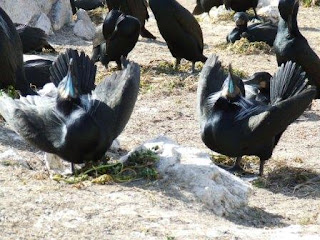The Murre Blind
Our main study plot on Upper Shubrick Point contains about 300 breeding pairs of Murres. Many of these birds have been fitted with unique color band combinations so that individuals can be followed throughout their lives. This information allows biologists to study survival of individuals over time, determine site and mate fidelity from year to year, understand the roles each sex plays in rearing the chick, and determine chick feeding rates among other things. Farallon biologists will typically spend 4 to 6 hours a day observing this plot to determine breeding success and diet of murres.
View from the window of the Murre Blind looking out over Shubrick Point at the murre colony.
The Cormorant Blind
Sea Lion Cove Blind
 Leaving the Corm Blind and heading northward on the island we arrive at the brand new Sea Lion Cove Blind. Equal parts form and function, this blind is entirely clad in copper and is the culmination of a unique partnership between PRBO, USFWS, and Meadowsweet Dairy, a group of local artists who specialize in creating wildlife habitat through art. Once again, Brandt’s Cormorants are the main attraction at this spot located just across Seal Lion Cove from the Corm Blind. This blind is unique, not only for its appearance but for the fact that it also creates breeding habitat by providing ledges for Murres and shielding both Murres and Corms from our daily activities allowing them to colonize new areas.
Leaving the Corm Blind and heading northward on the island we arrive at the brand new Sea Lion Cove Blind. Equal parts form and function, this blind is entirely clad in copper and is the culmination of a unique partnership between PRBO, USFWS, and Meadowsweet Dairy, a group of local artists who specialize in creating wildlife habitat through art. Once again, Brandt’s Cormorants are the main attraction at this spot located just across Seal Lion Cove from the Corm Blind. This blind is unique, not only for its appearance but for the fact that it also creates breeding habitat by providing ledges for Murres and shielding both Murres and Corms from our daily activities allowing them to colonize new areas.
An added benefit to the location of this blind is that it affords excellent photo opportunities such as this picture of two Brandt's cormorants displaying over a few scraps of nesting material. They are competing to attract a mate by fluttering their wings and showing off their bright blue throat.
These blinds provide us with the opportunity to get close enough to the breeding seabirds to observe their behavior and collect data about their reproduction, diet, and survival while also hiding us from view and protecting the seabirds from disturbance. During the summer months, we probably spend as much or more time in these blinds as we do living in the houses on the island and that is why we think of them as our home away from home.